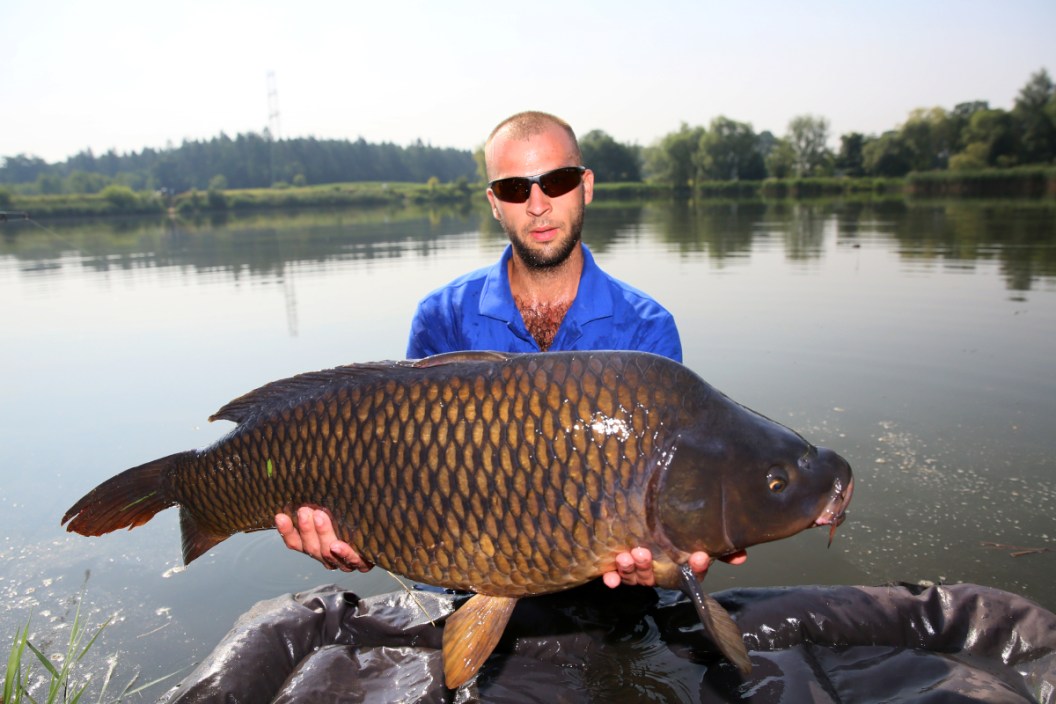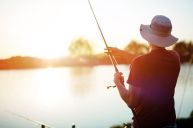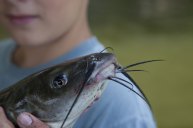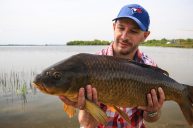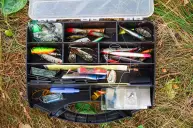Have you ever gone carp fishing?
Most anglers turn up their noses immediately when they hear the word "carp." Alas, these freshwater fish are often hit with the undeserved "trash fish" label. It's their loss. Carp anglers around the world know what an awesome fight a big carp can give.
Catching carp does require a change in tactics and fishing gear different from what most anglers are familiar with.
Today we'll give you plenty of carp fishing tips to get started carp fishing today.
Species of carp
Here in the United States, the two most common species you're going to encounter are either the common carp or grass carp. Over the years, I've noticed there is a much greater appreciation for carp over in Europe. But the species most commonly caught there is the mirror carp, which is basically just a subspecies of the common variety.
In any case, carp are usually all very similar in behavior and habitats. They can thrive just about anywhere, from a small farm pond to a large river to the largest freshwater bodies like the Great Lakes. I've seen carp living in both muddy and clear water. They don't really seem to have a preference. It's probably why they've been so successful as a species wherever they're introduced. Here in Michigan, I often see them living in irrigation ditches next to farmer's fields!
Most of that "trash fish" reputation likely comes from the fact these fish are bottom feeders and they can be quite destructive to native underwater habitat in some areas. If there is one species we don't like, it's the Asian carp because it's been more destructive than any other. Authorities are rightfully worried about this invasive species reaching the Great Lakes one day.
Carp fishing rigs
One thing to keep in mind when selecting carp fishing tackle is that while they might not look it, these fish are ferocious fighters. They remind us of catfish in a way. They may look fat and lazy, but once they realize they're in danger, the fight is on!
That's why we recommend heavier fishing line, fishing rods, and gear for carp. If you already own a heavy catfishing rod and reel, you already likely have fishing tackle suitable for carp fishing. Anglers generally use large spinning rod combos fitted with heavy monofilament, flurocarbon or braid. For most areas, 10-15-pound test will do for most areas. There are some specially-made carp rods on the market. However, these are usually sold in European markets where carp and carp fisheries are more popular.
The number of rigs you can tie to fish carp is nearly endless. Most carp fisherman use a size 4 or 6 hook, but some use smaller. Most serious carp anglers use a bait or circle-style hook with a short shank. These hooks are tied into a variety of bottom fishing rigs with weights and sinkers of 2 to 4 ounces.
We won't get too deep on sinkers, swivels, and weights here. Because that could be an entire article by itself. Just know there are a ton of options for a variety of angling situations when it comes to carp fishing.
It's worth looking into pre-made carp rigs. As I've already noted, carp fishing is huge in the United Kingdom and their tackle stores sell a variety of popular carp fishing rigs pre-made. Things like the popular hair rig, the snowman rig and the Ronnie rig are readily available on Amazon from anywhere from £8-12 (roughly $10-15 U.S.).
Unfortunately, ordering from the U.K. is your best bet for pre-made carp rigs as most tackle providers here in the United States don't sell them. You will likely have to pay some higher shipping costs, but it's easier than making a huge shopping list of the countless materials to tie your own rigs. Make sure to read carefully before you buy because some sellers don't ship to the U.S.
Oh, and don't forget rod holders, rod pods, and some sort of bell or other bite alarm. You will likely have to leave the rig in the water a long time and it's good to have something to alert you to when there's a tug at the line.
Bait for carp fishing.
The good news about carp is that they aren't picky eaters. In some places they annoy the heck out of catfish anglers because they continually eat up their bait. Many carp anglers make their own dough ball baits. There are numerous recipes out there to make the best baits from common household food sources like cereal, corn syrup, cornmeal, egg whites, sugar and flour. It will likely be the grossest thing you've ever cooked up in your kitchen, but the carp will love it!
Of course, there are also options to use simpler things for carp bait like night crawlers or other live bait in the right situation. One extremely popular bait is sweet corn. You can pick up several cans for cheap at the local dollar store and they'll last you through several fishing trips.
Another baiting method to try is boilies. As you might have guessed from the name, this is another fishing method that comes to us from our friends across the pond in the U.K. Basically, this is similar to a dough ball in that it's a combination of ingredients mashed together into a paste. The difference here is that like the name suggests, they're boiled. The result is a harder bait that resembles cat or dog food.
Boilies last longer on a hook than the standard dough balls or other baits, making them more efficient and popular with setups like the hair rig I mentioned earlier. Recipes for boilies abound online and you can also find pre-made ones for sale online.
Carp fishing on the fly.
Carp and fly fishing. Those are two words you likely never thought you'd see together. But believe it or not, carp fishing on the fly is an extremely popular, if niche, way of carp angling. Yeah, a carp isn't quite as beautiful as big rainbow trout. But few other fish are going to give the battle a 10- or 20-pound carp will on a fly rod.
Carp fishing flies are generally bulkier than what you'd use for other game fish species. Patterns like the Woolly Bugger or other large insect flies are what you'll find most fly anglers using. One thing to keep in mind with fly fishing for carp is that they require a much slower presentation than you'd normally use. Remember that carp aren't fast and aggressive unless they need to be.
Chasing carp on a fly will certainly test your patience, but the reward of catching such an unusual species with fly tackle is hard to beat. No wonder this type of fishing is taking off so quickly.
Is carp a good fish to eat?
This depends on who you talk to for the most part. Some people love carp. Other people loathe it. It's worth noting that in many parts of Asia, carp is a common food item sold in stores. We're guessing their bad reputation again comes from the stigma of this animal as a trash fish here in the states. But most parts of the world seem to be much more open-minded about carp as food than we are.
It is worth pointing out most people consider carp to be quite bony. If you don't mind that, you probably won't mind eating them. Many anglers say the quality of a carp meal is going to depend upon multiple factors. One, the body of water the carp came from and two, the way it is prepared.
One thing we should caution here is that sometimes carp can be found in very polluted waters. As a result, these fish might have dangerous levels of chemicals in them that can be harmful to humans. Keep an eye out for signs on the riverbank warning of such problems.
The Environmental Protection Agency groups carp in with fattier fishes like catfish and lake trout as ones that are more likely to be contaminated by pollution. Eat with caution!
Other carp fishing tips.
One thing I forgot to mention earlier is that carp are one of the more skittish species you can target. They may look fat and lazy, but they certainly aren't dumb, they will spook very easily. They kind of remind me of a pig in that way. You can't have a radio blaring away hard rock music on the riverbank while you're waiting for a bite. It will drive all the fish away. Putting chum in the water may help, just make sure to check local regulations before throwing anything in the water to attract them. Some states ban chumming completely.
When you do hook a fish, don't try to horse it in. Carp have very soft mouths and it is quite easy to rip the hook right out of their mouth. Along those same lines, don't slam the hook set the second you feel a tap. Carp often mouth the bait a bit before fully taking it into their mouth. Set the hook too early and you'll miss the fish completely. Give them time to really take the bait.
Our last tip is simply patience. It takes some trial and error to figure out what carp fishing method is going to work best in your area. But once you do hook into a big fish, you'll see what all the fuss is about.
For more outdoor content from Travis Smola, be sure to follow him on Twitter and check out his Geocaching and Outdoors with Travis YouTube channels.
NEXT: WATCH: GUY TAKES A LEAPING ASIAN CARP TO THE HEAD IN SLOW MOTION
WATCH
https://rumble.com/embed/u7gve.v3tr93/
